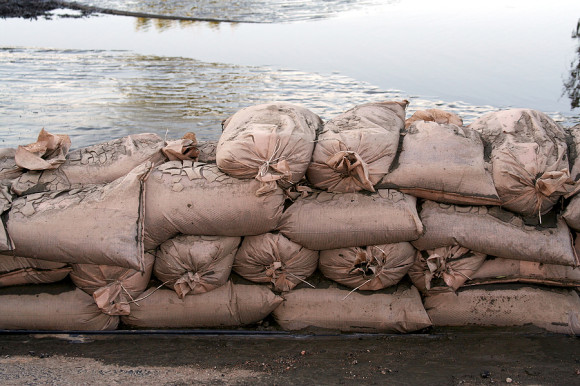One of the snowiest winters on record for the Midwest and northern U.S. Plains have crop watchers worried about a repeat of the massive flooding that hit one of the world’s top grain producing regions in 2008.
Accumulated precipitation this winter through the end of February, from northern Iowa into the southern two-thirds of Minnesota and westward to the Dakotas, ranged from 125 percent of normal to well over 200 percent, meteorologists say. That raises the risk of major flooding, especially in the big corn, spring wheat and soybean areas of North Dakota’s Red River Valley and the upper Mississippi River region. Illinois and Iowa alone produce almost a third of corn and soybeans in the United States, the world’s leading exporter of those industrial crops. North Dakota and Minnesota produce more than half of U.S. spring wheat and durum, the highest protein wheats.
“During the big Midwest floods of 2008, the rains came quickly and were constant. Flooding happened quickly,” said Karin Gleason, NOAA meteorologist who researched the effect of the 2008 floods. “Now it’s more of a wait-and-see situation as to when it will flood and by how much.”
U.S. and state officials are preparing for spring floods, with the areas surrounding the Red River running along the North Dakota-Minnesota border and the Mississippi River near St. Paul and Minneapolis southward at greatest risk.
National Weather Service forecasters predict moderate to major flooding for the region, at minimum, they said. “One of our biggest points of concern is St. Paul where we are looking at a one in two chance of seeing a record flood,” said Diane Cooper, NWS hydrologist for the Twin Cities office.
Snowmelt in the upper Mississippi has come early in recent years, compounding the situation. The Army Corps of Engineers, managers of the lock-and-dam river system, are lowering reservoir water levels two weeks earlier than normal, trying to beat the runoff, officials said.
“The chances of over-topping the miter gates are like 100 percent and over 50 percent for the lock wall,” said Ferris Chamberlin, chief of water management for the Army Corps in St. Paul. “Miter gates are what you open to let barges into the lock chamber. Once we get flow over the top of the miter gate we close navigation.”
LOOKING BACK
In 2008, rains pounded the northern Midwest from early June into July and caused tributaries into the vast Mississippi River watershed to overflow, flooding some tens of millions of acres of cropland in Iowa, Illinois, Indiana, Minnesota and Wisconsin. Those rains came on top of a wet summer and autumn in 2007, with conditions similar to the past year in the northwestern Corn Belt, climatologists say.
Grain prices soared during the summer of 2008 on fears of damage to the bellwether U.S. crops. But initial estimates of flood damage far exceeded final losses. Rains let up in July and corn farmers were able to replant, primarily to soybeans. Record crop prices in the end boosted farmer income. Iowa farmers received nearly $1.1 billion in insurance payments in 2008, with some $475 million due to floods or planting delays, according to an Iowa State University study.
This spring, all eyes will at first be on the Red River area that marks the Minnesota-North Dakota border. Local authorities have been filling sandbags for flood barriers, organizing emergency teams and fortifying major levees.
The timing of rains and how quickly floodwaters recede will hold the key to how many acres need replanting. Farmers in North Dakota and Minnesota are already expecting a late planting season given the heavy snow pack. Spring rains will only compound the situation.
“It would take a miracle right now for an early planting season. Maybe we can still pull off a relatively normal one — it’s amazing how much work can get done in a short time if the opportunity presents itself,” said Neal Fisher, head of the North Dakota Wheat Commission.
(Reporting by Christine Stebbins; editing by Jim Marshall)
Topics USA Flood Agribusiness Mississippi
Was this article valuable?
Here are more articles you may enjoy.



 Board Calls for US Steel to Address Safety Issues as It Rebuilds Site of Fatal Explosion
Board Calls for US Steel to Address Safety Issues as It Rebuilds Site of Fatal Explosion  Severity Was Up, But Will Falling Claims Volume Impact the Profession?
Severity Was Up, But Will Falling Claims Volume Impact the Profession?  Litigation Funding, Other New Laws in SE States Could Impact Liability Insurance
Litigation Funding, Other New Laws in SE States Could Impact Liability Insurance  2 New Jersey Pilots Killed in Helicopter Collision Frequented Nearby Cafe Together
2 New Jersey Pilots Killed in Helicopter Collision Frequented Nearby Cafe Together 

